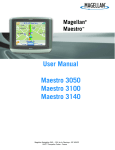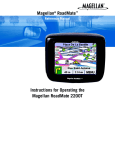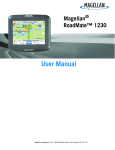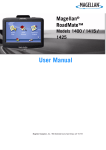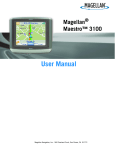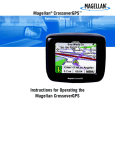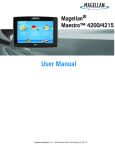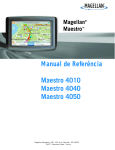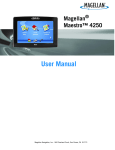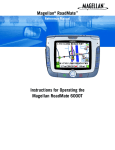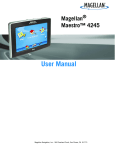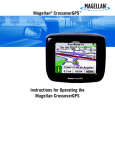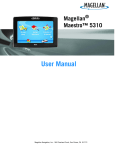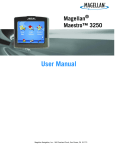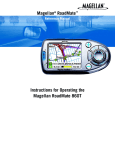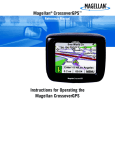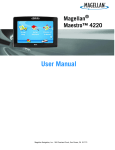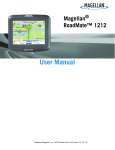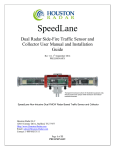Download Magellan 4010 GPS Receiver User Manual
Transcript
Magellan Maestro ® ™ User Manual Maestro 4010 Maestro 4040 Maestro 4050 Magellan Navigation, SAS. ZAC de la Fleuriaye - BP 60433 44477 Carquefou Cedex - France IMPORTANT SAFETY WARNINGS The Magellan Maestro is a vehicle-navigation aid designed to assist you in arriving at your selected destinations. When using the Magellan Maestro, these safety rules must be followed to prevent accidents that can result in injury or death to yourself or others: • • • • • • • • • Some countries prohibit mounting any item to your windscreen. Please check the applicable regulations in your country as regards windscreen mounting. Go to www.magellanGPS.com for alternate mounting solutions. An adhesive disk is supplied with the Magellan Maestro for use as an alternative mounting solution to the dashboard. When driving, the need to view the display is minimal. Voice prompts will guide you to your destination. The driver should enter data or programme the Magellan Maestro only when the vehicle is stationary. Only a vehicle passenger should enter data or programme the Magellan Maestro while the vehicle is moving. It is your responsibility to comply with all traffic laws. Every attempt is made to ensure that the database is accurate. However, roadways, points of interest (POIs) and business and service locations may change over time. The database does not include, analyse, process, consider or reflect any of the following: legal restrictions (such as vehicular type, weight, height, width, load and speed restrictions); road slope or grade; bridge height, width, weight or other limits; population density; neighbourhood quality or safety; availability or proximity of police, emergency rescue, medical or other assistance; construction work zones or hazards; road or lane closures; road, traffic or traffic facilities’ safety or condition; weather conditions; pavement characteristics or conditions; special events; traffic congestion. It is your responsibility to disregard any unsafe, hazardous or illegal route suggestions. Keep the Magellan Maestro safe from extreme temperature conditions. For example, do not leave it exposed to direct sunlight for an extended period of time. Take care when mounting the Magellan Maestro in your vehicle, whether using the windscreen mount or other mount or accessories, that it does not obstruct the driver’s view of the road, interfere with the operation of the vehicle’s safety devices such as air bags, or present a hazard to occupants of the vehicle should the Magellan Maestro be dislodged while driving. You assume the risks associated with damage to your vehicle or vehicle occupants as the result of your choices in mounting the Magellan Maestro. Laws in some countries prohibit wearing stereo headphones while operating a motor vehicle. Please check the applicable laws for the country in which you are driving. Proceed with caution when listening to music for prolonged periods of time through headphones, as this may lead to hearing loss. The battery in the Magellan Maestro is rechargeable and should not be removed. If it ever needs to be replaced, please contact Magellan Technical Support. About Charging the Magellan Maestro • • • • • Only use the AC adapter (Phihong: PSC2200R-050) approved for your Magellan Maestro. Use of another type of AC adapter can result in malfunction and/or a possible fire hazard due to battery overheating. Only use the car charger approved for/supplied with your Magellan Maestro. Use of another type of car charger will result in a malfunction and/or may be hazardous. The Magellan Maestro is intended to be supplied with a LISTED Power Unit marked with "LPS", "Limited Power Source" and output rated + 5 V DC/2.0 A". Use the USB cable approved for/supplied with your Magellan Maestro. For safety reasons, the battery in your Magellan Maestro will stop charging when the ambient temperature is below 0°C (32°F) or above 45°C (113°F). i IMPORTANT SAFETY WARNINGS About the AC Adapter • • • • • Do not use the adapter in a high moisture environment. Never touch the adapter when your hands or feet are wet. Allow adequate ventilation around the adapter when using it to operate the device or charging the battery. Do not cover the AC adapter with paper or other objects that will reduce cooling. Do not use the AC adapter while it is inside a carrying case. Connect the adapter to a suitable power source. The voltage and earthing requirements are found on the product case and/or packaging. Do not use the adapter if the cord becomes damaged. Do not attempt to service the Magellan Maestro. There are no serviceable parts inside. Replace the Magellan Maestro if it is damaged or exposed to excess moisture. About the Battery • • Do not attempt to replace the battery. Please contact Magellan Technical Support for issues related to the battery. Use the charger approved for your Magellan Maestro. ii IMPORTANT SAFETY WARNINGS Federal Communication Commission Interference Statement This equipment has been tested and found to comply with the limits for class B digital devices, in accordance with part 15 of the FCC Rules. These limits are designed to provide reasonable protection against harmful interference in a residential installation. This equipment generates, uses and can radiate radio frequency energy and, if not installed and used in accordance with the instructions, may cause harmful interference to radio communications. However, there is no guarantee that interference will not occur in a particular installation. If this equipment does cause harmful interference to radio or television reception, which can be determined by turning the equipment off and on, the user is encouraged to try to correct the interference by one of the following measures: • • • • Reorient or relocate the receiving antenna. Increase the distance between the equipment and receiver. Connect the equipment to an outlet on a different circuit to the one that the receiver is connected to. Consult the dealer or an experienced radio/TV technician for help. This device complies with Part 15 of the FCC Rules. Operation is subject to the following two conditions: (1) This device may not cause harmful interference, and (2) this device must accept any interference received, including interference that may cause undesired operation. FCC Caution: Any changes or modifications not expressly approved by the party responsible for compliance could void the user's authority to operate this equipment. IMPORTANT NOTE: FCC Radiation Exposure Statement: This equipment complies with FCC radiation exposure limits specified for an uncontrolled environment. End users must follow the specific operating instructions for satisfying RF exposure compliance. This transmitter must not be co-located or operated in conjunction with any other antenna or transmitter. In order to maintain compliance with FCC regulations, shielded cables must be used with this equipment. Operation with non-approved equipment or unshielded cables is likely to result in interference to radio and TV reception. The user is advised that changes and modifications made to the equipment without the approval of manufacturer could void the user's authority to operate this equipment. The Magellan Maestro must be installed and operated at a distance no closer then 8 inches (20 cm) from the user. This Class B digital apparatus meets all requirements of the Canadian Interference-Causing Equipment Regulations. iii IMPORTANT SAFETY WARNINGS IC statement Operation is subject to the following two conditions: 1. 2. This device may not cause interference and This device must accept any interference, including interference that may cause undesired operation of the device. IMPORTANT NOTE: IC Radiation Exposure Statement: This equipment complies with IC radiation exposure limits established for an uncontrolled environment. End users must follow the specific operating instructions for satisfying RF exposure compliance. This transmitter must not be co-located or operated in conjunction with any other antenna or transmitter. © 2007 Magellan Navigation, Inc. All rights reserved. The Magellan Logo, Magellan, Maestro, Turn it on and go, TrueView, QuickSpell, SmartDetour,and SmartVolume are trademarks of Magellan Navigation, Inc. No part of this user manual may be reproduced or transmitted in any form or by any means, electronic or mechanical, including photocopying and recording, for any purpose other than the purchaser’s personal use, without the prior written permission of Magellan Navigation, Inc. 631449-18 A iv Magellan Maestro The Magellan Maestro is a vehicle navigation product that uses GPS signals from satellites to calculate your precise location and compute detailed routes. As it knows its position and movement, it can then overlay this information on detailed maps provided by NAVTEQ® to provide a visual representation of your location. With the Magellan Maestro you can: • Store your home address and quickly obtain routing details to your home. • Create and save addresses in your address book that you can access at any time and obtain routing information to that address. • Route to an address that you enter using the keypad and Magellan’s QuickSpell feature for easy, error-free entry. • Route to any point of interest (POI) that has been preloaded into your Magellan Maestro. (Custom POIs can also be created and uploaded using the POI Manager software supplied on the included CD-ROM.) • Route to a POI that appears on the map while travelling simply by tapping on the POI icon. • Instantly obtain a list of all nearby auto-repair services. • Use the trip planner to create a trip with multiple destinations. Handy for business people who need routing information to many destinations. • Use the POI Near Exit tool that provides you with a list of petrol stations, restaurants, hotels and auto repair shops located nearby exits you are approaching that you can route to when travelling along a motorway. • Customise your Magellan Maestro to meet your needs. The interface for the Magellan Maestro is easy and simple to follow once you understand the basics. You may never need to refer to this manual but if you do we have tried to present it in a form that makes it easy for you to access the function you are trying to use and follow the steps provided. The Magellan Maestro has a built-in battery, so, in most cases, you will be able to follow these instructions while reading them on your computer screen without plugging it in to the AC power socket. You should note that while indoors you may not get any satellite signals, so your location information may not be updated. However, the power of the SiRFstarIII™ chipset installed in the Magellan Maestro will pick up satellite signals in some very demanding locations, so you may notice the Magellan Maestro computing a position, even indoors. Magellan Maestro 1 Front View A Microphone A 4.3 ”D isp l ay Side Views A B C D A SD/MMC card slot B Power on/off C USB connector D Reset E Headphone Jack (3.5mm mini jack) F Power input from cigarette lighter adapter or AC power adapter (+5 VDC / 2A). E F Back View A Speaker A Magellan Maestro 2 Installation Instructions Installation of the Magellan Maestro is simple and easy. The hardest part will be picking the best location. Selecting the Location A few tips on selecting a suitable location. • Mount the Magellan Maestro in a place where it can be easily seen and will not interfere with your view of the road. • The Magellan Maestro should be mounted in such a way that the antenna, (located in the top of the receiver), has an unobstructed view of the sky through the windscreen. • Select whether it will be mounted using the adjustable mount to the windscreen or the supplied adhesive disk. Make sure that you check your local and regional laws before mounting the device on the windscreen. Some countries have laws restricting the mounting of any device on the windscreen. • If planning to use the adhesive disk, a smooth surface on the dash board will need to be selected. Do not attach the adhesive disk to the windscreen. • Make sure that the Magellan Maestro or any cabling will not be disturbed if the airbags are activated. Cleaning the Area Use an alcohol pad to clean the area on the windscreen or dashboard that has been selected for mounting the Magellan Maestro. Applying the Adhesive Disk (Skip if mounting directly onto the windscreen.) Remove the protective tape from the back of the adhesive disk. Apply the disk with the adhesive side towards the dashboard. Maintain pressure on the disk for 5 minutes to allow it to set in place. Allow the disk 24 hours to cure before continuing. Attach the Cradle Line up the two mounting tabs on the cradle with the mounting slots on the bottom of the Magellan Maestro. Press the back of the cradle until it snaps into place with the back of the receiver. Please note that the mounting bracket supplied with the Magellan Maestro may be different to the one shown in this document. Installation 3 Attach the Adjustable Mount Align the two tabs on the adjustable mount with the holes on the back of the cradle. Once the adjustable mount is flush with the cradle, push the cradle and receiver assembly down until they lock into place with the adjustable mount. Secure the Mount to the Windshield or Adhesive Disk Make sure that the lever at the base of the adjustable mount is in the up position. Place the base of the mount firmly over the area of the windscreen to be used or the adhesive disk. Push the lever at the base of the mount all the way down until it snaps into place. Carefully let go of the assembly, making sure that it is securely mounted. Adjust the Mount for Optimum Viewing Loosen the adjustment locking knobs and position the Magellan Maestro for optimum viewing. Once set, tighten the locking knobs. (Never attempt to adjust the mount while driving.) Connecting Power Plug the end of the cigarette lighter adapter into a 12 VDC cigarette lighter receptacle in the vehicle. Connect the other end to the Magellan Maestro as shown. There is a wire catch on the side of the cradle to run the power cable through to prevent it from becoming disconnected. If there is power at the receptacle, the Magellan Maestro will power on. (Note: some vehicles apply power to the cigarette lighter receptacle only when the ignition is on.) Security We recommend that the Magellan Maestro is not left in plain view when unattended as it may attract thieves. The easiest method for removing the Magellan Maestro once the mount is in place is to unsnap it from the cradle by pressing on the tab at the top of the cradle. Installation 4 Fundamentals Powering on the Magellan Maestro The On/Off button is the silver button located on the left-hand side of the Magellan Maestro as shown in the Overview chapter. Turning the Magellan Maestro On 1. Press and hold the On/Off button for 1-2 seconds. 2. Read the Warnings and tap OK. Turning the Magellan Maestro Off 1. Press and hold the On/Off button for 1-2 seconds. Selecting Auto Power Off Time The Magellan Maestro can be set to shut down automatically after a time selected by you. The receiver will turn off after the selected time if; A) the position hasn’t changed and B) the touchscreen hasn’t been pressed. 1. Access the Main Menu. 2. Tap the Next arrow to access the Main Menu Page 2. 3. Tap User Options. 4. Tap System Settings. 5. Tap Power. 6. Select Auto Power Off time; Never, 10 Minutes, 20 Minutes or 30 Minutes. 7. Tap Save. 8. Tap the Back arrow to return to the Main Menu. Volume There are two ways to access the volume controls; the first is by tapping the speaker icon on the Map screen and the second is through User Options. Changing the Volume from the Map Screen. 1. Tap the speaker icon . 2. Tap on the Mute button to mute the volume, or tap inside the volume adjust bar below the Mute button to change the volume levels. 3. Tap Save. If you have muted the volume, the speaker icon will be displayed with a line through it, indicating it is muted. To unmute the volume, tap the speaker icon again. Fundamentals 5 Changing the Volume via User Options 1. Access the Main Menu. 2. Tap the Next arrow to access the Main Menu Page 2. 3. Tap User Options. 4. Tap System Settings. 5. Tap Volume. 6. Tap on the Mute button to mute the volume, or tap inside the volume adjust bar below the Mute button to change the volume levels. 7. Tap Save. Brightness Accessing the Brightness Control 1. Access the Main Menu. 2. Tap the Next arrow to access the Main Menu Page 2. 3. Tap User Options. 4. Tap System Settings. 5. Tap Brightness. 6. Tap inside the brightness adjust bar to set the desired brightness. 7. Tap Save. On the Brightness screen there is a checkbox for “On-battery dimming (75%)” When checked, the Magellan Maestro will dim to 75% of the brightness when operating exclusively on battery power. This prolongs the battery life between charges. It can be turned off by tapping on the checkbox. The Main Menu The Main Menu screen is the centre for all of the Magellan Maestro’s available functions. The Main Menu consists of two pages with large, easy to access icons. Accessing the Main Menu From the Map screen, tap the Menu button. From the other screens, tap the Back button. Fundamentals 6 Main Menu - Page 1 Show Map: Displays the map with your current position (if computing a position from the GPS signals) indicated by the blue triangle. See the Map Screen chapter for details. Enter Address: Displays Enter Address menu. Addresses can be entered by first entering the town, post code, or by selecting a town from a list of towns you have already used as destinations. Also provides access to your address book (my addresses) or to create a route to a town centre. See the chapter on Routing to an Address for details. POI-Points of Interest: Displays the Search Points of Interest menu. Search for POIs by entering the name or by selecting from a list of available categories. Marco Polo POIs and POIs that have been created and installed using the POI Editor software (found on the CD-ROM) can be accessed via this menu. For more information on the Search Points of Interest menu, see the Points of Interest chapter. Home: If you have created a Home address, press the Home button for quick access to routing to your home. If you have not created a Home address, you will be prompted (visually) to do so. See the Home Button chapter for more information. Roadside Assistance: Displays the Auto-service and Maintenance screen. For more information on this feature, see the Roadside Assistance chapter. Bluetooth: Displays the Bluetooth Main Menu screen. For more information on connecting to a mobile phone, see the chapter on Bluetooth. Fundamentals 7 Main Menu - Page 2 Trip Planner: Opens the Trip Planner menu where you can create, edit, delete, rename or activate a trip. POI Near Exit: (Accessible only while on a motorway.) Provides a list of restaurants, petrol stations, auto repair shops or hotels near approaching motorway exits. You can select one of the presented POIs and create a route to it. User Options: Accesses the User Options menu. This menu can be used to access functions used for tailoring the Magellan Maestro to your individual needs. Home: If you have created a Home address, press the Home button for quick access to routing to your home. If you have not created a Home address, you will be prompted (visually) to do so. See the Home Button chapter for more information. Roadside Assistance: Displays the Auto-service and Maintenance screen. For more information on this feature, see the Roadside Assistance chapter. Bluetooth: Displays the Bluetooth Main Menu screen. For more information on connecting to a mobile phone, see the chapter on Bluetooth. Fundamentals 8 The Keypad Understanding the keypad while entering an address is an important part of using your Magellan Maestro. The keypad is the most common method of entering data into the Magellan Maestro, and with key features like QuickSpell, data entry is quick and easy. Keypad Overview Special Keys Alphabetic Keypad Numeric Keypad Accented letters Keypad Spacebar Backspace Accept Fundamentals Cancel 9 Selecting From List After tapping “OK” to accept your input, you may be presented with a list of items found in the database. The sample given here shows the result of tapping “OK” after entering “LOND”. Use the scroll bar to move up and down the list and tap on the desired item in the list to continue. Fundamentals 10 QuickSpell™ QuickSpell uses information in the database to limit the keys that can be pressed to present only those which correspond with information in the database. For example, if you are looking for LONDON. As you ‘type’ in the name London, only keys that can spell a town in the database are shown. In the screen to the right, ‘LON “ has been entered. Keys that would not continue to spell a town in the database are greyed out.. This is to enable the town and street names to be entered quickly, without introoducing any errors due to typos. Notes on Entering Data If you are having trouble getting the results you expected, here are a few useful tips. • Make sure that you have spelled the name correctly. If you are unsure of the spelling, just enter a few characters and tap “OK”. A long list of names will be displayed, but you can step through the list and you will probably be able to find the correct spelling. • When the name of the town has a prefix such as ‘Saint’, ‘The’ ‘Le’, ‘La’ etc. you must enter this prefix in order to obtain the expected result. • When entering a street name, you can usually enter only one of the significant words in the street name to retrieve it from the database. However, if you are having trouble finding the street you are looking for, we recommend trying to type in its full name. • The more characters you enter, the smaller the list of entries found will be. Fundamentals 11 Map Screen The most commonly used screen will be the Map screen. Whether you are following a route or just travelling around town, the chances are that the Map screen will be displayed. There are two unique modes that the Map screen can be displayed in; normal and routing. In normal mode, your position is shown on the map along with the time and your speed. As you travel, your position will be updated, giving you a clear view of your position and surrounding streets. A B K C J D I E F G H Map Screen - Normal Mode A Street name currently on. B Direction indicator. Tap to view the Current Location screen where you can save your position into your Address Book. C Zoom out D POI icon. Tap on the POI icon to create a route to that POI. Note: If there are multiple POIs in the same area, a list of those POIs will be displayed. Tap on the name in the list to access the routing function. E Current position icon F Time of day G Main Menu button. Tap to display the Main Menu. H Current speed of travel I Volume control. Tap to display the Volume Setting screen where the volume can be adjusted or muted. (If the volume has been muted, tapping this button unmutes the volume without displaying the Volume Setting screen.) J Zoom in K Satellite Status. All four bars in green denotes the optimal satellite status. Tap to display the GPS Status screen. Map Screen 11 In routing mode additional information is displayed providing detailed information about the route you’ve selected. A B N C M D L E K J F G H I Map Screen - Routing Mode A Street name currently on. B Direction indicator. Tap to view the Current Location screen where you can save your position into your Address Book. C Zoom out D POI icon. Tap on the POI icon to create a route to that POI. Note: If there are multiple POIs in the same area, a list of those POIs will be displayed. Tap on the name in the list to access the routing function. E Current position icon F Next segment icon. Tap on the icon to display the List of Directions screen. G Distance to next segment. Tap to repeat the last voice command. H Main Menu button. Tap to go to the Main Menu screen. Note that the Main Menu screen is different when there is an active route. See the chapter on Routing for details. I Tap to toggle between the distance remaining to reach the destination and approximately how long it will take to arrive at the destination. J Street name for the next segment K Graphical representation of the route L Volume control. Tap to display the Volume Setting screen where the volume can be adjusted or muted. (If the volume has been muted, tapping this button unmutes the volume without displaying the Volume Setting screen.) M Zoom in N Satellite Status. All four bars in green denotes the optimal satellite status. Tap to display the GPS Status screen. Map Screen 12 Accessing the Map Screen 1. On the Main Menu, tap Show Map. 2D Mode The map is normally displayed in 3D mode but you can set the map to 2D mode if so desired. Choose the mode that is most suitable for you. In 2D mode, you can pan across the map looking for a location to route to or save in your address book. Setting the Map Modes (2D or 3D) 1. From the Map screen, tap MENU. 2. Tap the Next arrow to access page 2 of the Main Menu. 3. Tap User Options. 4. Tap Map Options. 5. Tap 3D Map or 2D Map. 6. Tap Save. Map Screen in 2D Mode Panning on the Map 1. While viewing the Map screen in 2D mode, slide your finger or stylus across the map. 2. The location icon changes to . (The circle is the crosshairs for a position and the red arrow points to your current location. 3. To exit panning, tap ESC and the map is returned to your current position. Saving a Position While Panning 1. Pan the map until the icon crosshairs are over the location you want to save to your address book. (Must be a position that does not have a POI icon displayed.) 2. Tap in the centre of the circle icon. (If nothing happens then you have not zoomed in enough. Tap the zoom in icon and try again.) 3. On the Route To This Address? screen, tap Save. 4. Edit Information: Tap Edit on the Edit Name line to create a name for this location. Tap on any of the three (work, home, mobile) phone buttons to enter a phone number. Tap Edit on the Edit Information line to add additional information. (Up to 35 characters can be entered.) 5. If you want to tag this location as one of your favourites, tap on the “Favourite” check box. 6. When the details for this address are acceptable, tap Save. Map Screen 13 7. If you want to now route to this address tap Route or if you have finished tap Cancel. 8. Tap ESC to exit panning and return the icon to your current position. Routing to a Panned Position 1. Pan the map until the icon crosshairs are over the location you want to route to. 2. Tap in the centre of the circle icon. (If nothing happens then you have not zoomed in enough. Tap the zoom in icon and try again.) 3. On the Route To This Address? screen, tap Route, 4. Select the desired routing method and tap the Calculate Route button. Current Location Screen This screen is accessed from the Map screen whether you are following a route or just driving around. The Current Location screen displays approximate address information, the next and previous intersections, as well as your latitude/longitude. To the right is a compass pointing in your direction of travel, the calculated elevation, and speed. The bottom bar displays the current time and date. Accessing the Current Location Screen 1. From the Map screen, tap the direction icon in the upper left-hand corner. Saving Your Current Location to Your Address Book 1. Access the Current Location screen. 2. Tap Save. 3. Edit Information: Tap Edit on the Edit Name line to create a name for this location. Tap on any of the three (work, home, mobile) phone buttons to enter a phone number. Tap Edit on the Edit Information line to add additional information. (Up to 35 characters can be entered.) 4. If you want to tag this location as one of your favourites, tap on the “Favourite” check box. 5. When the details for this address are acceptable, tap Save. Map Screen Saving Current Location 14 List of Directions Screen This screen is accessed from the Map screen and only when following a route. (Note: The List of Directions screen is not available until you begin moving on the route.) Each line in the list of directions provides details about the segment in the order that they are to be made, with the next segment at the top. The bottom bar of the List of Directions screen indicates the distance and time to the next segment as well as the total distance computed for the route. List of Directions The List of Directions can be modified if you want to exclude one of the segments, should you wish to avoid travelling along one of the listed streets. Instructions for excluding one of the segments are given in this chapter. Accessing the List of Directions screen 1. Tap the segment icon in the lower left-hand corner of the Map screen. This icon is displayed only when you are actively following a route. Excluding a Segment This is used for modifying the route, possibly to avoid routing along a particular street. 1. Access the List of Directions. 2. Tap on the item in the list with the street you want to try and avoid. 3. Confirm the exclusion by tapping on Exclude. (Tap the back arrow to cancel.) 4. The Magellan Maestro recalculates the route and displays the List of Directions with the newly computed segments. The highlighted section of the route is to be excluded from the route. The List of Directions displays the new route. Map Screen 15 GPS Status Screen 1. The GPS Status screen is also accessed from the Map screen and displays the status of the GPS satellites in a graphical format. (More technical information on the GPS status can be found in the User Options menu: Main Menu Page 2 > User Options > GPS Options > GPS Status.) Green bars indicate that the Magellan Maestro is using these satellites to compute the position; orange bars indicate that the Magellan Maestro is trying to lock on to the satellite signal; and no bar shown indicates a satellite that is not being tracked. The longer the bars, the better the signal. GPS Status Screen Accessing the GPS Status Screen 1. From the Map screen, tap the GPS Signal Strength icon in the upper right-hand corner. Tap on the back arrow to return to the Map screen. Zoom Levels There are 23 zoom levels in the Magellan Maestro, ranging from 100 feet to 1200 miles. Select the zoom level that best suits your needs. Setting Zoom Levels 1. While viewing the Map screen, tap on the (zoom in) or (zoom out). Volume The volume can be adjusted or muted from the Map screen. (The volume can also be adjusted from User Options > System Settings > Volume.) Changing the Volume from the Map Screen. 1. Tap the speaker icon . 2. Tap on the Mute button to mute the volume, or tap inside the volume adjust bar below the Mute button to change the volume levels. 3. Tap Save. If you have muted the volume, the speaker icon will be displayed with a line through it, indicating it is muted. To unmute the volume, tap the speaker icon again. Map Screen 16 Home Address Your home address can be entered and saved in the Magellan Maestro for quick and easy access when you need to create a route home. Creating a Home Address These instructions only apply if you have never entered a home address or if it has been deleted. 1. Tap the Home Address icon on the Main Menu screen. 2. Confirm “Do you want to enter your HOME address?” Tap Yes. 3. Follow the prompts to enter the address to be used as your HOME address. 4. When the Address screen is displayed, edit the information and tap SAVE to continue. 5. The HOME address will be saved in your address book and you will be returned to the Main Menu screen. Creating a Route to the Home Address 1. Tap the Home Address icon 2. Tap Route. 3. Select the desired Routing Method and tap the orange Calculate Route button. Home Address on the Main Menu screen. 17 Changing the Home Address 1. Tap the Home Address icon on the Main Menu screen. 2. Tap Change. 3. Confirm “Do you want to replace the HOME address with a new address?” Tap Yes. 4. Follow the prompts to enter the address to be used as your new HOME address. 5. When the Address screen is displayed, edit the information and tap SAVE to continue. 6. The new HOME address will be saved in your address book and you will be returned to the Main Menu screen. Accessing the Home Address from the Address Book 1. From the Main Menu, tap the Enter Address icon. 2. Tap the My addresses icon. 3. Tap Address Book. 4. Tap List All. 5. The list of addresses in your address book are displayed with the home icon on the line of your HOME address. 6. Tap on the home item in the list to create a route, edit or delete the HOME address. Home Address 18 Enter Address The Enter Address function is used to create a route to a newly entered address or to an address stored in your address book. Entering an Address If your Maestro is loaded with a map including several different countries (Maestro 4040 and Maestro 4050) you must first make sure that the correct destination country is selected. Selecting the destination country 1. From the Main Menu, tap the User Options icon. 2. Select the Destination Country option. A list of all countries that are preloaded in your Maestro will be displayed. Depending on the unit you are using, some of these countries may display a padlock beside their name. This padlock means that this particular country is locked and cannot be accessed. Visit www.magellanGPS.com for more information about buying unlock codes for these country maps. 3. Tap your destination country in the displayed list. The country is now selected and you will not have to repeat this process until you decide to travel in a different country. List of Countries Once you are sure that the correct destination country has been selected, the first step involved in creating an address is to indicate which town it is in. This can be done by inputting the name of the town, entering the postcode for the town or by selecting a town that has been previously used. Creating a Route to a New Address 1. From the Main Menu, tap the Enter Address icon. 2. Select the method you want to use to enter the town: Enter Town, Enter Post Code, or Previous Towns. Enter Town: Use the keypad with QuickSpell to enter the first few characters of the town name. Tap OK or continue entering letters until the display automatically switches to the list of towns found. Enter Address 19 Note: Remember to Enter the full name of the town INCLUDING any prefix or article. Tap on the desired town in the list. List of Towns Enter Post Code: Use the keypad to enter the post code for the destination address. Tap OK when the post code is complete. Tap on the desired town or area in the list. Towns matching the post code entered Previous Towns: Tap on the desired town in the list of previously selected towns. List of previously used towns 3. Enter Address With the town selected, the keypad will be displayed prompting you for the street name. Use the keypad with QuickSpell to enter the street name. Enter the first few characters of any significant word in the street name and tap OK or continue entering characters until the list of streets is displayed. 20 Examples for the city of Paris, France. You can search for Boulevard du Général de Gaulle by entering either ‘Gaulle’ to display a list of streets containing ‘Gaulle’.....: Entering “Gaulle” results in: or ‘Général’ to display a list of streets containing ‘Général’. Entering “Général’ results in: These are the two significant words in the street name. Entering ‘Boulevard’ or ‘Du’ would not have returned the appropriate result. 4. Use the scroll bar to the right, if necessary, to view the desired street name. Tap on the street name to continue. 5. Use the keypad to enter the street number for the address. Note in the top left corner is the range of acceptable street numbers. 6. Tap Done when the address is complete. 7. Select the desired routing method and tap the orange Calculate Route button to begin routing. Enter Address 21 My Addresses My Addresses is where you store addresses that you want to keep as future destinations, as well as access addresses that you have visited recently that may not be in your address book. The address book can hold up to 200 addresses (50 of those being marked as Favourites). Accessing the My Addresses Menu 1. From the Main Menu, tap the Enter Address icon. 2. Tap on the My addresses icon. 3. The My Addresses Menuwill be displayed. Previous Destinations Routing to a Previous Destination 1. From the Main Menu, tap the Enter Address icon. 2. Tap on the My addresses icon. 3. Tap on Previous Destinations. 4. Select the destination from the list of previous destinations. 5. Tap on Route. 6. Select the Routing Method and tap the orange Calculate Route button. Enter Address 22 Saving a Previous Destination to Your Address Book 1. From the Main Menu, tap the Enter Address icon. 2. Tap on the My addresses icon. 3. Tap on Previous Destinations. 4. Select the destination from the list of previous destinations. 5. Tap on Edit. 6. Apply any edits you want to make to this destination before saving. 7. Check Favourite if you want this addresses store in your address book as a favourite. 8. Tap Save to store the address. 9. The Previous Destination screen will be displayed. Tap Route to route to this destination, or tap the Back arrow to return to the list of previous destinations. Deleting a Previous Destination 1. From the Main Menu, tap the Enter Address icon. 2. Tap on the My addresses icon. 3. Tap on Previous Destinations. 4. Select the destination from the list of previous destinations. 5. Tap on Delete. 6. Confirm Deletion. Tap Yes. 7. The Enter Address Menu will be displayed. It is possible to delete all of the destinations in the Previous Destination List by accessing User Options > Address Book Options > Clear Previous. Enter Address 23 Address Book Accessing an Address in Your Address Book 1. From the Main Menu, tap the Enter Address icon. 2. Tap on the My addresses icon. 3. Tap on List addresses 4. Tap List All to view the entire contents of your address book, or tap on Search Address Book to search for entries by name. 5. From the resulting list of addresses, tap on the address record you require. Routing to an Address in Your Address Book 1. Access the address record from your address book as described in Accessing an Address in Your Address Book. 2. Tap on Route. 3. Select the Routing Method and tap on the orange Calculate Route button to continue. Editing an Address in Your Address Book. 1. Access the address record from your address book as described in Accessing an Address in Your Address Book. 2. Tap on Edit. 3. Use the Edit Address Book screen to modify the name, information or phone numbers. The street address cannot be changed. 4. Tap Save when done. Deleting an Address in Your Address Book. 1. Access the address record from your address book as described in Accessing an Address in Your Address Book. 2. Tap on Delete. 3. Confirm deletion. Tap Yes. 4. You will be returned to the list of addresses in your address book. If the list is now empty, you will be returned to the previous screen. Enter Address 24 Favourites Favourite addresses work just like other addresses in your address book. Addresses in your address book can be marked as favourites to speed up the search for frequently used addresses. Accessing an Address from Favourites 1. From the Main Menu, tap the Enter Address icon. 2. Tap on the My addresses icon. 3. Tap on Favourites 4. From the resulting list of addresses, tap on the address record you require. Routing to an Address from Your Favourites List 1. Access the address record from your Favourites as described in Accessing an Address from Favourites. 2. Tap on Route. 3. Select the Routing Method and tap on the orange Calculate Route button to continue. Editing an Address from Your Favourites List 1. Access the address record from your Favourites as described in Accessing an Address from Favourites. 2. Tap on Edit. 3. Use the Edit Address Book screen to modify the name, information or phone numbers. The street address cannot be changed. 4. Tap Save when done. Deleting an Address from Your Favourites List 1. Access the address record from your Favourites as described in Accessing an Address from Favourites. 2. Tap on Delete. 3. Confirm deletion. Tap Yes. Enter Address 25 Creating a New Entry This is used to create a new address and save it in your address book. You can create an entry by selecting it on the map, entering the address, selecting an address from the list of POIs or choosing a street intersection. Creating a New Entry in You Address Book by Selecting it on the Map 1. From the Main Menu, tap the Enter Address icon. 2. Tap on the My addresses icon. 3. Tap on Create New Entry. 4. Tap on Select on Map. 5. The Map screen will be displayed in 2D mode. Use your finger or stylus to pan around the map. When the crosshair icon is over the location you want to add to your address book, tap in the centre of the crosshairs. (Note: you may need to zoom into a lower zoom level if the edit Address Book screen is not displayed.) 6. Edit the name, information and phone numbers for the location you selected on the map. Tap the Favourites checkbox if you want this saved as a Favourite address. 7. Tap Save. Creating a New Entry in You Address Book by Entering an Address 1. From the Main Menu, tap the Enter Address icon. 2. Tap on the My addresses icon. 3. Tap on Create New Entry. 4. Tap on Enter Address. 5. Enter the address following the prompts. Detail on address entry can be found in this chapter in the Entering an Address section, 6. Edit the name, information and phone numbers for the location you selected on the map. Tap the Favourites checkbox if you want this saved as a Favourite address. 7. Tap Save. Enter Address 26 Creating a New Entry in Your Address Book from a POI 1. From the Main Menu, tap the Enter Address icon. 2. Tap on the My addresses icon. 3. Tap on Create New Entry. 4. Tap on Points of Interest. 5. Select the category from the list of POI categories. 6. If a subcategory list is displayed, select ALL Subcategories or one from the list. 7. Select search criteria: Near Current Position Displays POIs in the category selected nearest to your current position. If there are no POIs within a 100 mile radius, the search will be empty and an alert will be displayed. Near a Town: Enter a town name using the keypad (no QuickSpell) and select the desired town centre from the resulting list. This will display POIs in the selected category nearest to the selected town centre. Near Address: Enter an address using the standard address entry function. This will display POIs in the selected category nearest to the entered address. 8. Tap on the desired POI name on the list. Use the Prev and Next buttons to scroll up and down the list. 9. Edit the name, information and phone numbers for the selected POI. Tap the Favourites checkbox if you want to save this as a favourite address. 10. Tap Save. Enter Address 27 Creating a New Entry in Your Address Book from a Town Centre 1. From the Main Menu, tap the Enter Address icon. 2. Tap on the My addresses icon. 3. Tap on Create New Entry. 4. Tap on Town Centre. 5. Select search criteria: Near Current Position Displays Town centres nearest to your current position. Near a Town: Enter a town name using the keypad (no QuickSpell) and select the desired town from the resulting list. Near Address: Enter an address using the standard address entry function. This will display the town centres nearest to the entered address. 6. Tap on the desired town centre from the list. Use the Prev and Next buttons to scroll up and down the list. 7. Edit the name and information and tap the Favourites checkbox if you want to save this as a Favourite address. 8. Tap Save. Enter Address 28 Points of Interest (POI) The Magellan Maestro has preloaded POIs that can be used as a destination for a route. Selecting a restaurant or finding a petrol station nearby is as simple as tapping the screen!. Categories and Subcategories POIs are sorted into unique categories, with some of them being further sorted into subcategories. Restaurants have, for example, 54 subcategories that provide a way to search for restaurants serving Chinese food, fast food, or even Swiss food. Creating a Route to a POI by Category 1. From the Main Menu, tap the Points of Interest icon. 2. Select Search by Category. 3. Use the scroll bars to view the categories and tap on the desired category name. Category List 4. If a subcategory is displayed, use the scroll bars to view the subcategories and tap on the desired sub category name. Select ALL SUB CATEGORIES if you are unsure which subcategory best suits your needs. 5. Select the search criteria: Near Current Position, Near a Town (requires entering a town name) or Near Address (requires entering an address). Sub Category List 6. The top portion of the display shows detailed information about the highlighted POI in the list. The arrow and distance indicates the direction and distance in a straight line from your current position to the POI. Use the Prev and Next buttons to step up and down the list of POIs that were found. Tap on the POI name to continue. 7. Select the route method and tap on the orange Calculate Route button to begin. Points of Interest Chinese restaurants Near Current Position 27 Creating a Route to a POI by Name 1. From the Main Menu, tap the Points of Interest icon. 2. Select Search by Name. 3. Spell the name of the POI to be used as the destination. You need not enter the full name, but the more characters you enter, the easier it will be to find the exact POI you are searching for. 4. Select the search criteria: Near Current Position, Near a Town (requires entering a town name) or Near Address (requires entering an address). Sample Search by Name Input 5. 6. The top portion of the display shows detailed information about the highlighted POI in the list. The arrow and distance indicates the direction and distance in a straight line from your current position to the POI. Note that searching by name will show all POIs that meet the name criteria, regardless of the category. Use the Prev and Next buttons to step up and down the list of POIs that were found. Tap on the POI name to continue. Search Result for LOWE Near Position Select the route method and tap on the orange Calculate Route button to begin. Enhanced POIs Enhanced POIs are points of interest that can be downloaded from the Internet or created by the user by means of the POI Editor software found on the CD-ROM provided with your Maestro. The online help available in the POI Editor software describes how to edit POIs and how to transfer a POI file from your PC to your Magellan Maestro. After loading a POI file to the Maestro (or to a SD card and loading it in the Magellan Maestro) you can route to those POIs quickly. Loading a POI File from a PC 1. Turn your Magellan Maestro on and connect your Maestro to your PC using the supplied USB cable. 2. Launch the POI Editor software (you should have installed the software on your PC beforehand). Make sure your POI file is saved in Magellan mgln. format and use the transfer button to transfer the POI file to your Magellan Maestro. All POI files (including speedtrap files) must be first saved in the .mgln format using the provided POI Editor software before they can be transferred and used in the Magellan Maestro. Points of Interest 28 NOTE: by default all POI files are transferred to a folder called CPOI in the Maestro. If you are transferring a speedtrap file downloaded from the internet it is important that the file is copied to the subfolder named SPEEDTRAPS. 3. From the Main Menu, tap the Points of Interest icon. 4. Select Enhanced. 5. Select Change POI File. 6. Select Select a POI File. 7. Select the POI file to be loaded from the list of available POI files by tapping on the file name. POI File List Selecting Categories for Display on the Map A POI file must be loaded (see Loading a POI File) for this function to operate. 1. From the Main Menu, tap the Points of Interest icon. 2. Select Enhanced. 3. Select Change POI FIle. 4. Select Display Categories. 5. Use the checkbox to the left of the category name to select or deselect the category. (Checked means this category will have its icon displayed on the map.) Tap Mark All to check all categories or Clear All to uncheck all categories. 6. Tap Save when done. Enhanced POI Category List Points of Interest 29 Setting Alarms A POI file must be loaded (see Loading a POI File) for this function to operate. An enhanced POI can have an alarm that will alert you when you are in the range set in “Alert Parameters.” Note that all POIs in the selected categories will have their alarms set to on. A POI file must be loaded (see Loading a POI File) for this function to operate. 1. From the Main Menu, tap the Points of Interest icon. 2. Select Enhanced. 3. Select Change POI FIle. 4. Select Set Alarms. 5. Use the checkbox to the left of the category name to select or deselect the category. (Checked means that this category will have its alarms turned on.) Tap Mark All to check all categories or Clear All to uncheck all categories. 6. Tap Save when done. Setting Alarm Parameters An enhanced POI can have an alarm that will alert you when you are in a range set by “Alert Parameters.” Note that all POIs in the selected categories will have their alarms set to on. A POI file must be loaded (see Loading a POI File) for this function to operate. 1. From the Main Menu, tap the Points of Interest icon. 2. Select Enhanced. 3. Select Change My POI File. 4. Select Alert Parameters. 5. Select the category whose alarm parameters you wish to change from the category list. 6. Set the detection angle, the first warning and the last warning by tapping on the button with the current setting. 7. Use the keypad to enter new values and tap OK. 8. Tap Save when done. Points of Interest 30 Routing to an Enhanced POI A POI file must be loaded (see Loading a POI File) for this function to operate. 1. From the Main Menu, tap the Points of Interest icon. 2. Select Enhanced. 3. Select Select Category. 4. Select the category containing the POI you want to route to from the category list. 5. Select Nearest (near your current position) or Spell POI Name (requires entering the POI name). 6. Select the POI to be routed to from the “Select POI” list. 7. Tap Route. 8. Select the desired routing method and tap the orange Calculate Route button to continue. Saving an Enhanced POI to Your Address Book A POI file must be loaded (see Loading a POI File) for this function to operate. 1. From the Main Menu, tap the Enter Address icon. 2. Select Enhanced. 3. Select Select Category. 4. Select the category containing the POI you want to route to from the category list. 5. Select Nearest (near your current position) or Spell POI Name (requires entering the POI name). 6. Select the POI to be routed to from the “Select POI” list. 7. Tap Save. 8. Edit the POI information and tap Save. 9. The Route To This POI screen will be displayed again. Tap on Route to create a route or Cancel to quit. Marco Polo The Marco Polo Tour Guide is a special feature of the Magellan Maestro that gives users access to a special set of detailed POIs from Marco Polo Travel Guides. Magellan is happy to give you free access to the Sightseeing category for capital cities with detailed information regarding museum and monuments, etc. Other categories are locked and require a subscription to be viewed. Please visit www.magellanGPS.com for detailed information about subscribing to Marco Polo points of interest. Points of Interest 31 Travelling on a Route Map Screen When a route has been calculated it will be displayed on the Map screen in green with blue arrows indicating the direction of travel. The top of the screen displays the name of the street you are on. The bottom provides information about the next segment. As the route progresses, voice alerts will be used to prompt you of upcoming segments If you miss a prompt, or want it repeated, tap on field showing the distance to the next segment (bottom left of the screen) Map Screen with Route Shown There is also a bell that will alert you where the segment is to be performed. (This tone can be changed in User Options > Tone Options.) Split-Screen As you approach a segment, the Magellan Maestro will display a split-screen alerting you of the upcoming segment. This screen will close automatically as the segments gets closer, or you can tap ESC to close this screen and return to the Map screen. (This screen can be set to not to be displayed in User Options > Map Options.) Split-Screen List of Directions The List of Directions displays all of the segments required in order to complete the route and arrive at the destination. To view the List of Directions, tap on the segment icon in the bottom left corner of the Map screen. (The List of Directions is described in detail in the Map chapter of this manual.) List of Directions Travelling on a Route 32 You Have Arrived Finally, the Magellan Maestro will provide a visual alert when you have arrived at your destination. Tap the Back arrow to return to the Map screen. (The Magellan Maestro will automatically return to the Map screen after a fixed time if you do not tap the Back arrow.) You Have Arrived. Types of Routes There are a wide variety of methods you can use to create a route. Each method is discussed in the chapter which is associated with it. Some of the more common methods and the chapters in which they are described are: • A route to a new address • A route to an address in your address book • A route to a POI preloaded in the Magellan Maestro • A route to a Custom POI or Marco Polo POI • A trip (a route with multiple destinations) • A route to your home address • A route to a town centre Routing Method Regardless of which route type has been created, the Magellan Maestro needs to know how the route is to be calculated. Routes can be calculated by Shortest Time, Shortest Distance, Least Use of Motorways or Most Use of Motorways. To select the route method, tap on the radio button for the desired method. The Magellan Maestro can be set to avoid toll roads as much as possible by tapping on the Avoid Toll Roads checkbox. The View on Map button displays the Map screen with the destination shown. Tap on ESC to return to the Routing Method screen. Routing Method When the route method has been selected and you are ready to begin calculating the route, tap on the Calculate Route button. Calculate Route button Travelling on a Route 33 Special Routing Functions When a route is active, the Main Menu functions are changed to support special routing functions. Routing to a POI Near an Approaching Motorway Exit Note: This function is available only while on a motorway. Also, when you create a route to a POI near an exit, the original route will be cancelled. You will need to reset the original route when you are ready to continue. 1. From the Map screen, tap MENU. 2. Tap the POIs Near Exit icon. 3. Tap on the POI icon (restaurant, petrol station, auto repair or hotel) for the exit required. 4. A list of POIs in the selected category that are near the selected exit will be displayed. 5. Tap on the POI in the list that you want routing directions to. 6. Select the Routing Method and tap the orange Calculating Route button. POIs Near Exit List Cancelling a Route 1. From the Map screen, tap MENU. 2. Tap the Cancel Route icon. 3. Confirm that you want to cancel the route. Tap Yes. Detouring off a Route 1. From the Map screen, tap MENU. 2. Tap the Detour icon. 3. Select the distance to avoid that will be used to calculate the route and then return toy to your original route. 4. Tap Route. 5. The detour will be calculated using the same routing method that was used to create the route. Travelling on a Route 34 Changing the Route Method If you travel off the computed route, the Magellan Maestro will automatically re-calculate the routing information to get you to your original destination using the routing method you selected when creating the route. However, if you want to change the routing method (while on or off the route), you will need to use the re-route function. 1. From the Map screen, tap MENU. 2. Tap the Reroute icon. 3. Select the desired routing method and tap the orange Calculate Route button. Travelling on a Route 35 Roadside Assistance Overview Touching the tow truck icon displays the list of all the Points of Interest listed in the Auto Service and Maintenance category that are close to your current position. Accessing Roadside Assistance 1 From the Main Menu, tap on the tow truck icon. Tap on the tow truck to access Roadside Assistance. 2 The list of garages close to your current position is displayed with contact information. If you have a Bluetooth mobile phone paired to your Maestro (see the Bluetooth chapter) just touch the telephone number to call. Tap on the telephone number to call using your Bluetooth mobile phone. Knowing your current position If you need assistance when travelling, it is likely that you will have to know your exact position to efficiently direct the assistance or emergency services. To find your exact position, tap the upper left corner of the Map screen. The Locate screen will display detailed information about your current position, including the next and previous intersection. Note that you can save your current position in your address book (see the Map Screen chapter for more information about the Locate screen). Roadside Assistance Tap the Save button to store your current position in your address book. 36 Trip Planner The Trip Planner is used to create a route with multiple destinations. In this document we will refer to a route with multiple destinations as a “Trip”. Creating a Trip 1. From page 2 of the Main Menu, tap the Trip Planner icon. 2. Select New from the Trip Planner Menu. 3. Use the keypad to enter a name for this trip. 4. Tap OK. Enter a Trip Name 5. Begin by adding the first destination in the trip. Tap Add. 6. Select the method to be used to find or create the destination icon: Enter Address, Address Book, POIs, or City Centre. 7. Follow the instructions for the method chosen to select the destination. See the chapters on Enter Address and POI for help in selecting destinations. 8. Tap add to begin When the destination is found the Add Address to Trip screen will be displayed. Tap Save. Tap Save to Add the Address Trip Planner 37 9. The list of trip destinations will be displayed. First Destination Added 10. Tap on the destination name to bring up the menu. 11. Repeat steps 5 to 9 until the trip is complete with all your desired destinations. Tap on destination to open menu. 12. Tap Save to store the trip as it is, or tap Optimise to let the Maestro sort the destinations to make the full trip as short as possible. Saving completed trip. Trip Planner 38 Starting a Trip 1. From page 2 of the Main Menu, tap the Trip Planner icon. 2. Select Guide Me from the Trip Planner Menu. 3. Select the trip to be used from the stored trips list. 4. Tap on the destination in the list to be used as the first destination in the trip. In the example shown, tapping on ‘Merton’ would activate a trip from Merton to Tooting and finally Mitcham. 5. Select the routing method to be used and tap the orange Calculate Route button. 6. Select first destination. Editing a Trip 1. From page 2 of the Main Menu, tap the Trip Planner icon. 2. Select Edit from the Trip Planner Menu. 3. Select the trip to be edited from the stored trips list. 4. Tap on the destination to be edited. You can: Add a destination after the selected one. Move the destination up in the list. Move the destination down in the list. Delete the destination from the trip. Let the Maestro optimise your trip. 5. Trip Planner Edit Trip When the trip has been edited, tap Save. 39 Deleting a Trip 1. From page 2 of the Main Menu, tap the Trip Planner icon. 2. Select Delete, Rename from the Trip Planner Menu. 3. Tap Delete. 4. Select the trip to be deleted from the stored trips list. 5. Confirm that you want to delete the trip. Tap Yes. Trip Planner 40 Renaming a Trip 1. From page 2 of the Main Menu, tap the Trip Planner icon. 2. Select Delete, Rename from the Trip Planner Menu. 3. Tap Rename. 4. Select the trip to be renamed from the stored trips list. 5. Use the keypad to edit the name of the trip. 6. Tap OK. Trip Planner 41 POI Near Exit The POI Near Exit function provides a way of accessing commonly used POIs that are near an exit you are approaching while travelling on a motorway. POI Near Exit include restaurants, petrol stations, auto repair shops and hotels. POI near Exit can be accessed while following a route or just driving without a route, as long as you are on a motorway. Routing to a POI Near an Approaching Motorway Exit Note: This function is available only while on a motorway. Also, when you create a route to a POI near an exit, the original route will be cancelled if you are following a route. You will need to reset the original route when you are ready to continue. 1. From the Map screen, tap MENU. 2. Tap the POI Near Exit icon. 3. Tap on the POI icon (restaurant, petrol station, garages or hotel) for the required exit. 4. A list of POIs in the selected category that are near the selected exit will be displayed. 5. Tap on the POI in the list that you want routing directions to. 6. Select the Routing Method and tap the orange Calculating Route button. POI Near Exit POI’s Near Exit List 41 Bluetooth Introduction The Bluetooth function of the Magellan Maestro allows you to use the Magellan Maestro as a handsfree device for a Bluetooth enabled mobile phone. You can answer and dial your phone by using the Magellan Maestro touchscreen.. Accessing the Bluetooth Main Menu 1. From the Main Menu screen, tap : Bluetooth Main Menu Pairing Mode If this is the first time the feature has been used and no mobile phone has been paired or connected, the system will automatically switch to “Pairing Mode” and will wait for you to pair your mobile phone. To pair a new phone, or if the automatic pairing process was cancelled the first time it was used, you must pair the phone with the Magellan Maestro before the Bluetooth function can be used. Pairing a Phone with the Magellan Maestro 1. Access the Bluetooth Main Menu. 2. Tap on the Pair with a Device icon. 3. The pairing search screen will be displayed. Pairing will fail if the process cannot be completed within 1 minute. 4. To pair your mobile phone, please consult the user manual for your mobile phone. During the pairing process for your mobile phone you will be asked to input a passkey. You can enter any combination of numbers but 1111 is recommended. Bluetooth Pairing Search 42 5. A passkey input window will pop up on your Magellan Maestro. In this popup window, you will need to input the same numbers as you entered into your mobile phone.. Passkey Request screen Establish Connection Once paired, you will still need to establish a connection with the mobile phone if the message “No paired phone connected” appears at the bottom of the Bluetooth Main Menu screen. If your mobile phone doesn’t support “Hands-free” services and just supports the “Headset” service, you needn’t connect. If you dial a number from your mobile phone or receive an incoming call the “Headset” service will connect automatically. The main interface will display a status message "xx connected, partial function supported only", Establishing a Bluetooth Connection 1. Access the Bluetooth Main Menu. 2. Tap the Search for Devices icon. 3. The Searching for devices screen will appear. Once a device has been found, it will return to the Bluetooth Main Menu with a message at the bottom of the screen indicating that a device is connected. Place a call Placing a Call 1. Access the Bluetooth Main Menu. 2. Tap the Call icon. • You can enter 13 characters: “0~9”, * and # with the buttons on the keypads. Input “+” by pressing * for about 1 second. • You can tap to delete the phone number you have entered. Press the button for about half a second and the entire row will be deleted. • Bluetooth Once you have entered the phone number you want to dial, tap Call screen to place the call. 43 Placing a Call Using the Address Book 1. Access the Bluetooth Main Menu. 2. Tap the Call icon. 3. Select the search criteria; List All or Search Address Book. 4. After searching or listing your entire address book, select the address from the displayed list. 5. If there is a phone number recorded for the address “w:” (work), “h:” (home) or “m:” (mobile) will appear as a button. Tap the desired button and the call will be initiated. Placing a Call Using Call History The “Call History” window displays a list of Incoming / Outgoing / Missed. calls. 1. Access the Bluetooth Main Menu. 2. Tap the Call History icon. 3. Select the type of calls to be displayed. Incoming Calls Outgoing Calls Missed Calls Call screen 4. Tap Tap to call back. to delete a selected record. Tap to delete all records on the page. Placing a Call Using Redial 1. Access the Bluetooth Main Menu. 2. Tap the Redial icon. Failed Call If a call fails due to network problems or other unknown reasons, the “Dialling Failed” window will pop up: • Tap to redial. • Tap to cancel dial. Bluetooth 44 Call Connected If a call connects, the “Connected” window will pop up: • Tap to display a keypad to enter the extension after you have been connected. • Tap to transfer the call to your mobile phone. • Tap to turn off the microphone in the Connected screen Magellan Maestro. • Tap to end the call. Incoming call Answering an Incoming Call 1. When there is an incoming call, the “Incoming Call” window will pop up: Tap to answer the incoming call. Tap to mute the incoming call ring. Tap to reject the incoming call. Incoming Call Bluetooth 45 Traffic To receive traffic information on your Magellan Maestro you will need an enhanced traffic cradle. This cradle comes as standard with the Maestro 4050 and is included with the optional Magellan TrafficKit for Maestro 4010 and 4040. This cradle will give you access to free traffic information on major roads across Europe and to lifetime premium services in France or Great-Britain (Information about activating the lifetime subscription to premium traffic services in France or Great-Britain are provided with the Magellan Maestro 4050 or Magellan TrafficKit). Traffic Cradle The antenna for receiving the traffic alert signals is located in the traffic cradle. If you are experiencing difficulties in obtaining traffic signals, you may need to reposition the Magellan Maestro or use an external FM antenna (not supplied). Traffic Cradle Connections All of the connections to the traffic cradle are optional with the exception of power. Left-hand Side External FM antenna (not supplied) Alternate Power (hard wired installation) External GPS antenna (not supplied) Traffic 46 Right-hand Side External microphone (not supplied) Power External speakers/ headset (not supplied) Glossary of Terms RDS: Radio Data System. Infrastructure that broadcasts digital information on the FM band. The TrafficKit module can only receive and decode the free-access service. Traffic: Traffic Message Channel, one of the types of information that a Radio Data System can broadcast. TrafficKit: TrafficKit is the Magellan brand name for the RDS-Traffic module which receives the Traffic messages. Traffic Message: A message received by the TrafficKit module that contains the description of a Traffic event. Traffic Event: An event liable to disturb the flow of traffic. The list of possible Traffic events that can be received are provided below, along with the corresponding road sign: Danger Stationary Traffic Slow Traffic Lane Reduction Road Work Accident Closed Road Traffic 47 Severe Weather Severe Weather Vehicle Related Restriction Alert Mode: Traffic events are received for informational purposes. Re-routing Mode: This mode will reroute the vehicle if a Traffic event impacts the route, and a faster alternative route is available. Features of Traffic Alerts • You can enable and disable Traffic alert categories. By default, all categories are enabled. • Selected Traffic alerts will either alert and/or re-route you depending on the operating mode selected. • All selected alert categories will be displayed on the map screen in the form of traffic event icons. • If you are not routing to a destination, traffic alerts will only be displayed on the Map screen. Selecting Categories of Traffic Alerts You may select or deselect traffic alert categories, therefore giving you full control over which categories will be displayed and which ones will not. Selecting Traffic Categories Traffic 1. From page 2 of the Main Menu, tap User Options. 2. Scroll down the list and select Traffic Options. 3. Select Incident Options. 4. In the displayed list, check all categories of Traffic alerts (incidents) you want processed, and deselect events that are of no interest. For optimum routing Magellan recommends leaving all of the boxes checked. 5. Select the Save button to confirm all your choices. . 48 RDS-Traffic Operating Modes Traffic events that have an impact on your route can be processed in one of the following two modes: Re-routing Mode. (Default) Traffic events affecting your route will trigger the receiver to automatically calculate a new route, if a faster alternative route is available. Alert Mode. Traffic events affecting your route will be reported to you in the form of warning messages. Re-routing Mode Setting the Re-routing Mode 1. From page 2 of the Main Menu, tap User Options. 2. Scroll down the list and select Traffic Options 3. Select Traffic Selection. 4. Unless this has already been done, check the Traffic Active option 5. Check the Use alternative route option. Note that this causes the button just underneath to be renamed “Reroute option”. 6. Select the Reroute Option button on the screen. A new screen appears on which you can set the distance from the event that will trigger the alternative route. . Check one of the following options: Live Alert: With this option checked, the receiver will search for a faster alternative route whenever a Traffic event occurs on your current route. This will happen as soon as the event is received, regardless of your distance to the event. Dist. to event < 40 mi: With this option checked, the receiver will re-route you only if the distance to this Traffic event, is less than 40 miles from your current location (not a pointto-point distance but a distance measured along the route). Dist. to event < 20 miles: Same as above for a distance of 20 miles. Dist. to event < 10 miles: Same as above for a distance of 10 miles. 7. Traffic Select Save to confirm your choice and then Save again to return to your guidance screen. 49 Travelling with the Re-routing Mode On The following will occur whenever a Traffic event that affects your route is received: • The receiver will analyse the impact this event will have on your route. • A “Re-calculating the route” message will pop up on the screen along with the reason for the re-calculation. • Once the alternate route has been computed, it will compare the alternative route with the original route, and will decide which is the best route to follow, taking time and distance into consideration. • If the original route is still the best one to follow, the route will be unchanged and the time portion of the status bar will be updated to reflect the delay. The traffic icon will appear in the lower right-hand corner of the map display. Tapping this icon brings up a list of the traffic events on the route. • If the alternative route is the best route to follow, the receiver will start guiding you along this route. • The map screen will also show road signs corresponding to Traffic events, including those not affecting the route. • Events that affect your route will also appear as road signs in the list of directions. Alert Only Mode This mode will not provide you with new routing information, it will only alert you to the event. 1. From page 2 of the Main Menu, tap User Options. 2. Scroll down the list and select Traffic Options 3. Select Traffic Selection. 4. Check the Traffic Active option and unsure that the Use alternative route option is deselected. 5. Select the Alert Options button on the screen. A new screen will appear on which you can set the options relevant to the Alert mode. Check one or more of the following options: Live Alert: Once you have checked the options, the receiver will inform you of a traffic event located along your route as soon as it is detected. Reminder at 40 mi: If you check this option, the receiver will remind you of the traffic event it received earlier. The message will appear when this event, located somewhere along your route, is 40 miles away from your current location (not a point-to-point distance but measured along the route). Traffic 50 Reminder at 20 mi: Same as above but the distance from the event is only 20 miles Reminder at 10 mi: Same as above but the distance from the event is only10 miles Select Save to validate your choices and then return to your usual guidance screen. 6. Travelling with the Alert Mode On When you use the TrafficKit in the Alert Mode, the following will occur when new Traffic events are received: • If an event affects your route, a warning message will appear on the screen at a time or distance defined in the Alert Options menu. • If you do not acknowledge the message by pressing the ENTER button, it will automatically disappear after 10 seconds. Additional warning messages, if any, will appear in turn on the screen. • Events that affect your route will also appear as road signs in the list of directions and also in the lower part of the True View screen. See examples below: • The map screen will show road signs corresponding to the Traffic events, including those which do not affect the route. You can obtain detailed information on any event by selecting the icon on the map screen. A dialog box will open containing a description of the event. Traffic Alert Icon If a traffic incident occurs on your route, the traffic alert icon will be displayed in the lower right-hand corner of the map screen. Viewing Traffic Details While viewing the Map screen and travelling on a route, tap on the Traffic Alert icon when it is displayed. A Traffic Event List is displayed with all known traffic incidents listed in order of distance from your current position on your route. Traffic 51 Tap on one of the listed events to receive additional details about the traffic event. (Detailed information can also be displayed by tapping on an event icon displayed on the map.) Viewing Traffic Details at Higher Zoom Levels To avoid cluttering the screen, as you zoom out beyond the 8-mile zoom level, only the following events are displayed: • Accidents • Slow traffic (moving less than 20 mph) • Road closed • Special equipment required • Severe weather. Disabling Traffic Alerts 1. From page 2 of the Main Menu, tap User Options. 2. Scroll down the list and select Traffic Options 3. Select Traffic Selection. 4. Deselect the Traffic Active box 5. Click Save to confirm your choice. When the RDS function is off all incoming Traffic messages are ignored. Traffic 52 Viewing Traffic Signal Status 1. Access the Main Menu and select User Options. 2. Scroll down the list and select Traffic Options 3. Select Traffic Selection. 4. Deselect the Traffic Active box 5. Click Save to confirm your choice. When the RDS function is off all incoming Traffic messages are ignored. Traffic FAQs Q1- How does the TrafficKit module choose how frequently to receive Traffic data? A1: This is an automated procedure. When you turn on the system, the TrafficKit module analyses the 5 best frequencies stored in its memory. These frequencies are classified in order of signal strength. The module then checks to see whether Traffic data is available on the first station. If the first station is sending Traffic messages, the module will stay on that frequency, otherwise it will test the next one until it finds a station that delivers Traffic data. If none of the 5 frequencies can be used, the TrafficKit module will start scanning the entire FM band. It will search for the best five frequencies on which Traffic data is available and will tune in to the strongest station. These five best frequencies will be saved in memory to be used the next time the system is powered up. Q2- Why do we have to wait between 2 and 5 minutes before the RDS module starts delivering RDS data the first time we use it? A2: This is the average time for the module to test all the possible frequencies on the FM band and choose the best one in terms of signal level and Traffic data availability/quality. Traffic 53 Setting User Options Use User Options to customize the Magellan Maestro to better suit your needs. Tapping the Back arrow from any of the User Option screens will cancel the changes. Setting the destination country If several countries are preloaded in your Magellan Maestro the correct country must be first selected for your destination. 1. From page 2 of the Main Menu, tap User Options. 2. Tap Destination Country. Select an available country from the list. Countries that are locked show a padlock beside their name. Visit www.magellanGPS.com for information about unlocking maps. Select your destination country Accessing System Settings Commonly used settings are found in the System Settings section of User Options. 1. From page 2 of the Main Menu, tap User Options. 2. Tap System Settings. System Settings Menu Setting User Options 54 Checking Battery Life 1. From page 2 of the Main Menu, tap User Options. 2. Tap System Settings. 3. The battery life indicator is found at the bottom of the screen. All green indicates a full battery life. Battery Life Indicator Adjusting the Volume Volume can also be adjusted by tapping on the speaker icon on the Map screen. 1. From page 2 of the Main Menu, tap User Options. 2. Tap System Settings. 3. Tap Volume. 4. Tap along the adjustment bar to increase or decrease the speaker volume. 5. Tap Mute to turn the speaker off. Tap Mute again to turn the speaker back on. 6. Tap Save. Volume Setting Setting User Options 55 Adjusting the Display Brightness 1. From page 2 of the Main Menu, tap User Options. 2. Tap System Settings. 3. Tap Brightness. 4. Tap along the adjustment bar to increase or decrease the display brightness. 5. Tap On-battery dimming (75%) to set it on or off. (Checked is on.) If checked, battery life will be saved when operating the Magellan Maestro without external power. 6. Tap Save. Brightness Setting Setting Auto Power Off Time The auto power setting will define the time that the Magellan Maestro will automatically turn off if it hasn’t moved or the touchscreen hasn’t been accessed. 1. From page 2 of the Main Menu, tap User Options. 2. Tap System Settings. 3. Tap Power. 4. Select Never, 10 Minutes, 20 Minutes or 30 Minutes. 5. Tap Save. Auto Power Settings Setting User Options 56 Selecting Language The Magellan Maestro can be operated using English, French, German, Spanish, Dutch, Finnish, Italian, Portuguese, Swedish, Danish or Norwegian as the language for displayed text and voice commands. 1. From page 2 of the Main Menu, tap User Options. 2. Tap System Settings. 3. Tap Language. 4. Select the required language. 5. Confirm language. Tap Yes. 6. Tap Save. Setting Time Zone 1. From page 2 of the Main Menu, tap User Options. 2. Tap System Settings. 3. Tap Time Zone. 4. Use the “-” and “+” buttons to step through the time zones until the time zone for your area is displayed. 5. Check Daylight Savings if daylight saving is in effect for your time zone. (Daylight saving is not automatically adjusted.) 6. Tap Save. Time Zone Settings Selecting Units of Measure 1. From page 2 of the Main Menu, tap User Options. 2. Tap System Settings. 3. Tap Units of Measure. 4. Select Miles/Feet or Kilometers/Meters. 5. Tap Save. Setting User Options 57 Displaying Contact Us Information 1. From page 2 of the Main Menu, tap User Options. 2. Tap System Settings. 3. Tap 4. Tap Contact Us. 5. Tap Back arrow. . Contact Us Information Displaying Product Information 1. From page 2 of the Main Menu, tap User Options. 2. Tap System Settings. 3. Tap Next. 4. Tap Product Information. Product Information, Page 1 5. Tap Next to view additional product information. Tap Prev to return to page 1. 6. Tap the Back arrow to exit. Product Information, Page 2 Setting User Options 58 Performing Diagnostics 1. From page 2 of the Main Menu, tap User Options. 2. Tap System Settings. 3. Tap Next. 4. Tap Diagnostics. 5. Tap Audio Test, Touchscreen Test or Video Test. 6. When done, tap the Back arrow to exit. Accessing the Trip Computer The trip computer records your average speed, the time in hours of the trip, the time in hours that you were driving, and the distance of the trip. This information can be saved to a file for easy access when the information is needed. 1. From page 2 of the Main Menu, tap User Options. 2. Tap Trip Computer. 3. Select the Current Trip or a Saved Trip from the list. 4. Select Stop to stop recording information. Select Reset to set all the information to zero. Select Reset when you are starting a trip or route that you want to record details for. Current Trip Computer Select Save to save the trip computer information to a file. You will be prompted to enter a name for the file. Enter a name and tap OK. 5. Tap the Back arrow to exit. Setting User Options 59 Selecting POIs to be Displayed on the Map In some areas the map can be cluttered with POIs, making it difficult to find what you are looking for. Use POI Selection to set which categories of icons will be shown and which will be hidden. 1. From page 2 of the Main Menu, tap User Options. 2. Tap POI Selection. 3. Tap on the POI category in the list to toggle its display setting on or off. (Checked POIs will be displayed. Tap Mark All to check all POI categories. Tap Clear All to uncheck all POI categories. 4. Tap Save to save changes and exit. POI Selection Screen Deleting Addresses from the Address Book (Global) The chapter on addresses discusses how to delete individual addresses from the address book. Address Book Options provides a way of globally deleting addresses from the address book. 1. From page 2 of the Main Menu, tap User Options. 2. Tap Address Book Options. 3. Tap Clear Addresses to delete all of the addresses in your Address Book. Tap Clear Favourites to delete only those addresses marked as Favourites from your Address Book. Tap Clear Previous to delete previous destinations from the Address Book. 4. Tap the Back arrow to exit. Setting User Options 60 Setting the speedtrap alerts Your Magellan Maestro is preloaded with the location of speed cameras, so you can be alerted when approaching a speed control area. By default, the Speedtraps file is selected. This option provides a way to select another speedtrap file, to select speedtrap categoriess that are displayed on the map, to set alarms for each speedtrap category and to set up the alert parameters. Please refer to the Enhanced POIs section in the Points of Interest chapter for more information about doing this. Speedtraps can easily be updated by downloading a new file from the internet and using the Magellan POI Editor PC Tool. When loading a new speedtrap file remember that it should be first converted to the Magellan.MGLN format using the POI Editor PC Tool and then copied to the SPEEDTRAPS subfolder on your Magellan Maestro. 1. From page 2 of the Main Menu, tap User Options. 2. Tap Speedtraps. See the Enhanced POIs section in the Points of Interest chapter for detailed information about setting alerts. Setting the Map in 3D or 2D Mode See the chapter on Maps for information regarding 3D and 2D map modes. 1. From page 2 of the Main Menu, tap User Options. 2. Tap Map Options. 3. Select 3D Map or 2D Map. 4. Tap Save to record the changes and exit. Setting the Map Display to Heading Up or North Up The map can be displayed with the top of the display in the direction of your heading or North. 1. From page 2 of the Main Menu, tap User Options. 2. Tap Map Options. 3. Select Heading Up or North Up. 4. Tap Save to record the changes and exit. Setting User Options 61 Setting Split Screen (TrueView™) Options As you approach a segment, the display will change to the split screen mode. Under Map Options you can turn off the split screen or set it to be just the TrueView portion of the split screen. 1. From page 2 of the Main Menu, tap User Options. 2. Tap Map Options. 3. Tap Auto TrueView to set it to on or off. (Checked is on and the TrueView image will be displayed.) 4. Tap Split TrueView to set the TrueView display to split or single view. (Checked sets split screen on.) TrueView Split Screen 5. TrueView Single Screen Tap Save to record the changes and exit. Setting Auto Night Map Display Normally the map is displayed in pastel colours for daytime use and a black background for nighttime use. Unchecking the Auto Night Mode will keep the map display that uses pastel colours. 1. From page 2 of the Main Menu, tap User Options. 2. Tap Map Options. 3. Tap on Auto Night Mode. (Checked indicates that the map will automatically change to night colours; unchecked and the map will always use the day colours.) Note: If the screen has already switched to night colours, unchecking the box will not cause the display to switch to the day colours. The switch to day colours will occur the following morning and then stay in the day colour mode.) 4. Tap Save to record the changes and exit. Setting User Options 62 Setting Detour Options Use this option to select the default for the distance to be used to detour around traffic problems while routing. 1. From page 2 of the Main Menu, tap User Options. 2. Tap Detour Options. 3. Select the default for the distance to be used to detour around traffic problems while routing. Set the alert timer. (Enter the time using the keypad.). This is the time after which the Maestro offers to detour you when it registers that you are stuck in slow or stopped traffic on a motorway. Detour Options Screen Check Enable automatic detour on or off. (Check this option on and the Magellan Maestro will automatically detour you when it registers that you are stuck in slow or stopped traffic on a motorway.) 4. Tap Save to record the changes and exit. Using the Simulator When turned on, the simulator will offer the option of simulating movement on a route. Useful for learning about the Magellan Maestro while not driving. 1. From page 2 of the Main Menu, tap User Options. 2. Tap Simulator Mode. 3. Tap Propose simulator mode when calculating route. When checked, the Magellan Maestro will ask if you want the route simulated when it is created. Simulation mode will ignore actual movement and should only be used for training purposes. Tap on the desired speed factor. Tap <<1mi or 1mi>> to set the route forward or backwards 1 mile. Simulator Mode Screen Tap Restart to restart the route you are currently simulating from the beginning. Tap Stop stop the current route simulation. (The Simulate button is currently not active.) 4. Tap Back arrow to record the changes and exit. Setting User Options 63 Setting Tone Options Provides a way of selecting the tone used to announce arrival at a segment or destination. 1. From page 2 of the Main Menu, tap User Options. 2. Tap Tone Options. 3. Select Bell, Chime or Beep. 4. Tap Save to record the changes and exit. Setting Navigation Instructions (Magellan Maestro 4040 and 4050 only) Use this option to set which instructions will be announced using text-to-speech. 1. From page 2 of the Main Menu, tap User Options. 2. Tap Navigation Instruction. 3. Tap Announce street name to check or uncheck. When checked, street names will be announced using text-to-speech. Tap Announce exit sliproad to check or uncheck. When checked, exit sliproads will be announced using text-to-speech 4. Tap Save to record the changes and exit. Viewing Technical GPS Information This screen provides technical information about the satellites being used to compute the GPS position. 1. From page 2 of the Main Menu, tap User Options. 2. Tap GPS Options. 3. Tap GPS Status. PRN: pseudo random number that identifies the satellite AZ: Azimuth of the satellite EL: Satellite elevation SNR: Satellite signal-to-noise ratio TTFF: Time to First Fix (in seconds) 4. Tap Back arrow to exit. Setting User Options 64 Setting the GPS Position Setting a GPS position is useful if you are not obtaining satellite information quickly because the Magellan Maestro has travelled over 500 miles / 800 kilometres while turned off. Setting the GPS position will allow the Magellan Maestro to compute which satellites are available and calculate the position more quickly. 1. From page 2 of the Main Menu, tap User Options. 2. Tap GPS Options. 3. Tap Set GPS Position. 4. Follow the prompts to enter your current address. 5. Tap Done when you have finished entering the address. Backing Up and Restoring Data Backup and restore provides a way of storing the address book and other data to a SD/MMC card. When the data has been backed up, it can be restored at any time. Please note that when you restore from backed up data, address book and other data will be replaced with the data. The Magellan Maestro cannot append backed up data to your existing data. Backing Up Data 1. From page 2 of the Main Menu, tap User Options. 2. Insert a SD or MMC card with available space into the SD slot on the Magellan Maestro. Note that backing up data will overwrite any back up files on the SD or MMC card. 3. Tap Backup and Restore. 4. Tap Backup. 5. Confirm backup. Tap Yes. 6. Operation successful! Tap OK. 7. Tap Back arrow to exit. Setting User Options 65 Restoring Data 1. From page 2 of the Main Menu, tap User Options. 2. Insert a SD or MMC card with available space into the SD slot on the Magellan Maestro. Note that backing up data will overwrite any back up files on the SD or MMC card. 3. Tap Backup and Restore. 4. Tap Restore. 5. Confirm restore. Tap Yes. 6. Operation successful! Tap OK. 7. Tap Back arrow to exit. Viewing Map Information 1. From page 2 of the Main Menu, tap User Options. 2. Tap Map Information. 3. Tap Back arrow to exit. Map Information Screen Traffic options 1. From page 2 of the Main Menu, tap User Options. 2. Tap Traffic Options. Please see the Traffic chapter for detailed information about receiving traffic information on your Magellan Maestro. Setting User Options 66 Premium POI Subscription Your Magellan Maestro is preloaded with points of interest from Marco Polo travel guides. The Sightseeing category can be accessed free of charge for capital cities, but a subscription is required to access the other categories of Marco Polo POIs. To subscribe to Marco Polo Premium POIs, visit www.magellanGPS.com. 1. From page 2 of the Main Menu, tap User Options. 2. Tap Premium POI Subscription to display a screen showing your current subscriptions to Premium POIs. 3. Tap New to enter a new subscription code to Marco Polo Premium POIs. Subscription codes can be purchased from www.magellanGPS.com. 4. Tap Back arrow to exit. Setting User Options 67












































































